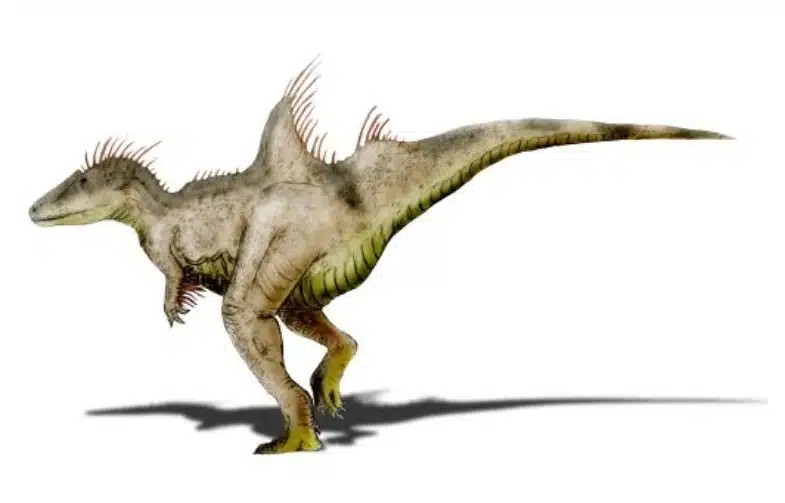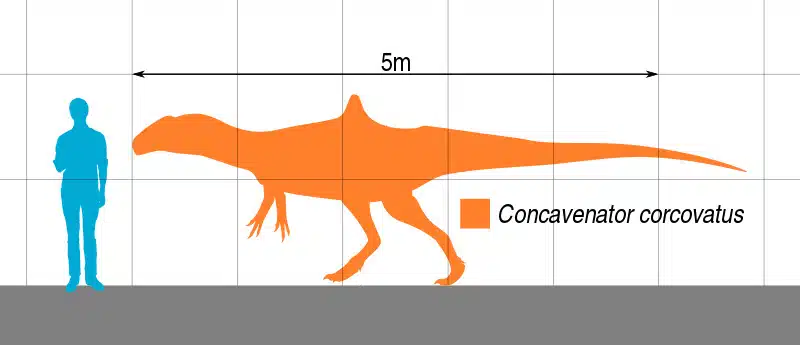Concavenator, with its unique hump and predatory prowess, is a marvel of the Early Cretaceous period. In this article, we’ll journey back in time to explore the life and times of the Concavenator.
Key Facts
| Concavenator pronunciation | con-cave-ah-nay-tore |
| Meaning of name | Cuenca hunter with a hump |
| Group | Theropod |
| Type Species | Concavenator corcovatus |
| Diet | Carnivore |
| When it Lived | 130.0 to 125.45 MYA |
| Period | Early Cretaceous |
| Epoch | Late/Upper Barremian |
| Length | 16 to 20 feet |
| Height | 6-6.5 feet |
| Weight | 700 – 900 lbs. |
| Mobility | Moved on two legs |
| First Discovery | 2003 by José Luis Sanz, Francisco Ortega and Fernando Escaso |
| Location of first find | Castilla-La Mancha, Spain |
| Described by | 2010 by José Luis Sanz, Francisco Ortega and Fernando Escaso |
| Holotype | MCCM-LH 6666 |
Concavenator Origins, Taxonomy and Timeline
Concavenator, whose name means ‘Cuenca hunter,’ is a testament to the diversity and adaptability of life during the Early Cretaceous period. ‘Conca’ refers to the Spanish province of Cuenca, and ‘venator’ translates to ‘hunter’. This ‘Cuenca hunter’ truly lived up to its name as a formidable predator of its time.

Belonging to the Theropoda group, Concavenator is a member of the Carcharodontosauridae family. Its type species is Concavenator corcovatus. This classification places it among the larger bipedal dinosaurs known for their carnivorous diet and predatory nature.
The timeline of this carnivorous dinosaur is set in the Early Cretaceous period, specifically the Late Barremian epoch. This places its existence around a time when dinosaurs were the dominant terrestrial vertebrates.
Listen to Pronunciation
Discovery & Fossil Evidence

The first discovery of Concavenastor fossils were made in 2003 in the region of Castilla-La Mancha in Spain. The find was made by Spanish paleontologists José Luis Sanz, Francisco Ortega, and Fernando Escaso. They also described the dinosaur for the first time in 2010, bringing this unique creature to the attention of the scientific community.
The fossil evidence is intriguing. The fossils found were well-preserved and provide a wealth of information about the dinosaur’s physical characteristics. The discovery of this dinosaur has significantly contributed to our understanding of its unique physical features. These traits have been the subject of much discussion and speculation.
Concavenator Size and Description
This is a dinosaur that stands out not just for its unique features but also for its size. This predator, belonging to the Theropoda group, was a frightening presence in its time.
It was a bipedal dinosaur that moved on two legs. Its most striking feature was the protrusion above its hips, thought to have supported either a sail or a hump. Structures on its forearms that appear to be quill knobs suggest that it may have displayed sparse protofeathers from its lower arms. Impressions found along with the skeletal material reveal that it had wide, rectangular scales on the underside of its tail and feet, resembling those of a bird.
Size and Weight of Type Species

It was approximately 5.8 to 6 meters long. This size places it among the larger theropods. The weight of Concavenator is not known, but given its size it would have been a substantial creature. The size and weight would have made it an intimidating predator in its time.
The Dinosaur in Detail
Concavenator is a dinosaur that stands out for its unique features. The protrusion above its hips, thought to have supported either a sail or a hump, is a feature not seen in many other dinosaurs. This structure, caused by the extension of two presacral vertebrae, has been the subject of much speculation. Some suggest that it could have been used for thermo-regulation, while others believe it could have been a means of recognizing others of its species. Some even suggest that it could have been used to store fatty tissue that helped the dinosaur survive prolonged periods without food.
Another unique feature of Concavenator is the presence of structures on its forearms that appear to be quill knobs. If this interpretation is correct, Concavenator may have displayed sparse protofeathers from its lower arms. However, no feathers have been found preserved with the specimen so this theory awaits further evidence for confirmation. A later study considered the possibility that these quill knobs might actually be due to muscular scarring.
Impressions found along with the skeletal material reveal that Concavenator had wide, rectangular scales on the underside of its tail and feet, resembling those of a bird. The underside also had a covering of scutes and plantar pads. These details provide a fascinating glimpse into the physical characteristics of this unique dinosaur.
These physical characteristics provide a fascinating glimpse into the diversity and adaptability of life during the Early Cretaceous period. This dinosaur, with its unique features and predatory prowess, is a testament to the wonders of the prehistoric world.
The Concavenator in its Natural Habitat

This carnivore lived during the Early Cretaceous period in a time when the earth was warm and the sea levels were high. The environment it lived in was likely lush and diverse with a variety of vegetation and other life forms. As a carnivore, Concavenator would have preyed on other dinosaurs and possibly even marine life. Its bipedal nature suggests that it was a fast and agile hunter and capable of chasing down its prey with ease.
Its diet would have consisted of other smaller dinosaurs and possibly even fish. Sharp teeth and strong jaws would have made it a successful predator. The dinosaur’s bipedal locomotion would have given it the speed and agility necessary to hunt effectively.
The unique features, such as its hump or sail and possible protofeathers, suggest that it was well-adapted to its environment. These could have served various purposes from thermo-regulation to social signaling. The unique adaptations and predatory nature make it a fascinating subject of study, providing insights into the diversity and adaptability of life during the Early Cretaceous period.
Interesting Points about Concavenator
- This is one of the few dinosaurs that had a unique protrusion above its hips, thought to have supported either a sail or a hump.
- Structures on its forearms that appear to be quill knobs suggest that it may have had sparse protofeathers on its lower arms.
- It had wide, rectangular scales on the underside of its tail and feet that resembled those of a bird.
- In typical fashion for therapods, it was a bipedal dinosaur that moved on two legs.
- It was a large predator with sharp teeth and strong jaws that may have fed on marine life as well as smaller dinosaurs.
Contemporary Dinosaurs
Concavenator coexisted with a wide range of European dinosaurs. Among them were Iguanodon, Baryonyx, and Hypsilophodon. These fellow dinosaurs, each unique in their own right, played their part in the complex balance of competition and cohabitation.
Iguanodon, an herbivore of considerable size, likely grazed on the abundant vegetation. Its feeding habits possibly influenced the availability of plant resources for the prey of Concavenator. The smaller Hypsilophodon, nimble and quick, could have been one of these potential prey for Concavenator. Baryonyx, on the other hand, with its distinctive long, narrow snout and large claws, might have been a competitor. Its piscivorous diet (meaning it ate fish) suggests a potential rivalry for aquatic prey.
In this fascinating panorama of life, C. corcovatus stood as a central figure, its existence shaped by and in turn shaping the lives of its contemporaries. The interplay between these dinosaurs, their potential competition for resources, and their possible predator-prey relationships paint a vivid picture of a dynamic ecosystem.
List of All Dinosaurs
We have created a list of all dinosaurs we have covered here, sorted across the seven main groups of dinosaurs. We also include information about their type of diet, (omnivore, herbivore or carnivore) and the time they lived.
Frequently Asked Questions
The name means ‘Cuenca hunter.’
Its most unique feature was the protrusion above its hips, thought to have supported either a sail or a hump.
It belonged to the Theropoda group and the Carcharodontosauridae family.
It was a carnivore that preyed on other dinosaurs and possibly even marine life.
It lived during the Early Cretaceous period, specifically the Late Barremian epoch around 130 to 125.45 million years ago (MYA).
Sources
- https://www.nature.com/articles/nature09181
- https://www.researchgate.net/publication/230808558_The_phylogeny_of_Tetanurae_Dinosauria_Theropoda
- https://www.researchgate.net/publication/273143583_Osteology_and_phylogenetic_relationships_of_Tyrannotitan_chubutensis_Novas_de_Valais_Vickers Rich_and_Rich_2005_Theropoda_Carcharodontosauridae_from_the_Lower_Cretaceous_of_Patagonia_Argentina
- https://www.sciencedirect.com/science/article/abs/pii/S0195667113000608
- https://journals.plos.org/plosone/article?id=10.1371/journal.pone.0156251
This article was last fact checked:Joey Arboleda, 06-11-2023
Featured Image Credit: Nobu Tamura, CC BY-SA 3.0, via Wikimedia Commons
